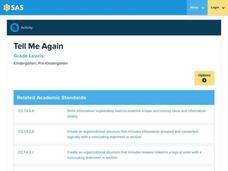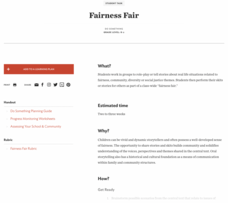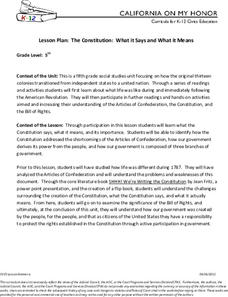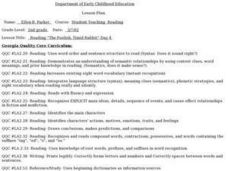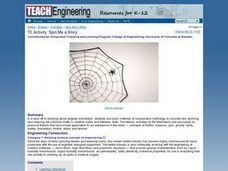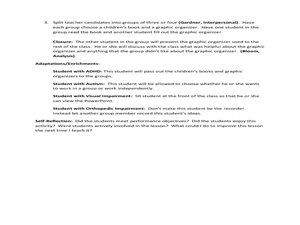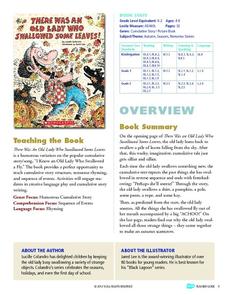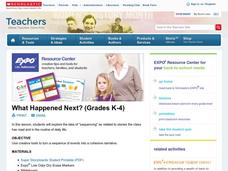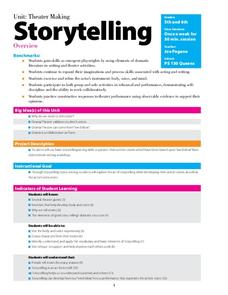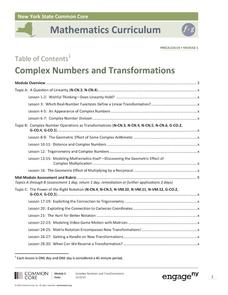Curated OER
Story vs. Plot
Students, after reading and discussing the two texts by Flannery O'Connor, "Good Country People" and "Greenleaf," analyze the plot, tone, characters, themes and setting in each story. They write their own short stories dealing with a...
Pennsylvania Department of Education
Tell Me Again
Students demonstrate how to retell a story in sequential order. In this reading comprehension lesson plan, students listen to a suggested read aloud, such as Little Boy Blue. Additionally, students practice retelling the story by using...
Curated OER
Illustrating and Writing a Short Story
Students use their art materials to go outside and draw a picture of a scene. They can also write down specific notes in a small spiral notebook about the scene they want to remember so they can write their stories. They complete their...
Curated OER
B-movies and Plot: Story Elements, Writing, Media
Students use old "B-Movies" as a springboard to discuss and analyze traditional plot structures. They form groups and make their own 'movie' to demonstrate their knowledge.
Teaching Tolerance
Fairness Fair
How can we create a more fair world? Chances are, class members have some ideas! After reading a text about fairness, individuals create skits around the ideas of fairness. Extend the learning and make their presentations a...
National Endowment for the Humanities
Doing Oral History with Vietnam War Veterans
Get the story from those who experienced it. Engage learners with a structured oral history project involving Vietnam War era veterans. By conducting thoughtful interviews, class members learn what it was like to serve in the...
Judicial Branch of California
The Constitution: What It Says and What It Means
Learners get the chance to act as representatives to the Constitution Convention, and must decide whether or not to recommend your state ratify the new framework. After examining the Constitution line-by-line, they consider their...
Curated OER
Exploring Film Genres for Telling Hero Stories: Narrative Shorts
Students research that a narrative film tells a story using camera movement, sound, lighting, editing and other film making techniques. The audience must be taken into consideration when making a film. They explore what makes their hero...
Curated OER
Language Arts: Plotting Stories
Second graders read the story, "The Foolish, Timid Rabbit," as part of a unit on appearances. After reading with partners, they write their own stories that include elements about some forms of matter from their science studies. Students...
Curated OER
The Mad Pursuit Search for the Structure of DNA
Students complete a variety of activities as they study the historical story of Rosalind Franklin not receiving credit for her contributions in discovering the structure of DNA.
Curated OER
Spin Me a Story
Young scholars examine the motif of spinning and weaving in myths and folktales. They read various myths, complete a WebQuest, develop a mind map of story elements, and write an original "spider" story.
Curated OER
Identifying the Theme in a Story
Middle schoolers recognize Theme through the use of simple, short stories. Using Pro Quest, students begin by researching the literary element, theme, and how it can be identified. They then identify the themes in Aesop's...
Curated OER
Graphic Organizer Lesson
Learners investigate how to use graphic organizers. In this literary elements lesson plan, students are introduced to several types of graphic organizers and their purpose. Learners read a book of their choice and complete a graphic...
Curated OER
A Plump and Perky Turkey
Help readers recognize elements in a story. They will use pictures and text to gain meaning from written material. Have learners listen to the story A Plump and Perky Turkey and participate in a discussion. They recognize the...
Curated OER
Events and Effects
Explore the plot structure in biographies. First, read the biography The Story of Jackie Robinson, Bravest Man in Baseball and identify specific events that possibly changed the life of Jackie Robinson. As you guide your listeners, they...
Curated OER
Sally's Super Day
Second graders engage in a lesson that is about having a super day with an example of a fictitious child. They read "Sally's Super Day" and reflect upon the events and how they affected the character and the outcome of the story. The...
Curated OER
There Was An Old Lady Who Swallowed Some Leaves Storia Teaching Guide
There was an old lady who swallowed some leaves? Little learners read a new version of the old swallow story with a fall twist as they try to answer the big question; Why is that lady swallowing all that weird stuff? The teacher's guide...
Curated OER
Monster Plants Storia Teaching Guide
Who wouldn't want to read a book about monster plants? Get those kids into informational texts with an engaging topic, like meat eating plants! You'll use the teaching guide to provide structured practice as your class reads to...
PBS
Broadcast News
Just because a story is on the news doesn't mean it's being presented fairly. Analyze news broadcasts with a lesson focused on evaluating television journalism. At home, kids watch a news show and note the stories presented, including...
Curated OER
Alphabet Poems
Develop fluency with a variety of works. Help kindergartners use multiple strategies to understand text and decoding. They will create an alphabet poem book on Kid Works 2 to illustrate and write their own poem. In the end, they will...
Curated OER
Acid Rain
Create a simulation of acid rain in your classroom with lemon juice and bean plants to help kids study the effects of pollution on plants. In addition, learners will listen to a story and write responses based on guiding questions.
Scholastic
What Happened Next? (Grades K-4)
Explore the structure of narrative writing with this fun, collaborative instructional activity. Start by reading aloud a short story, asking small groups of learners to fill in key events on a large story board prepared on the class...
New York City Department of Education
Theater Units for Lower and Upper Elementary Levels
Introduce middle schoolers to playwriting and the elements of drama with a six-session storytelling unit that encourages kids to expand their acting and writing skills. The 12-page packet includes overviews of the lessons,...
EngageNY
Complex Numbers and Transformations
Your learners combine their knowledge of real and imaginary numbers and matrices in an activity containing thirty lessons, two assessments (mid-module and end module), and their corresponding rubrics. Centered on complex numbers and...



